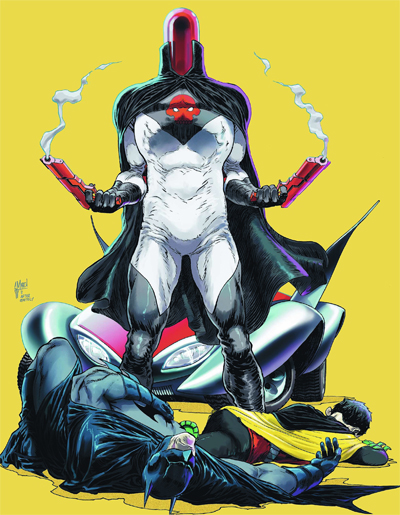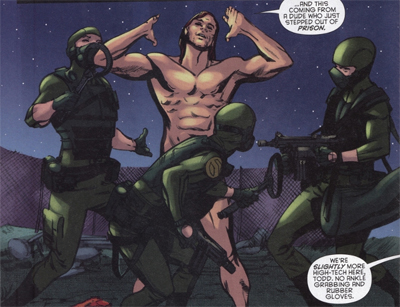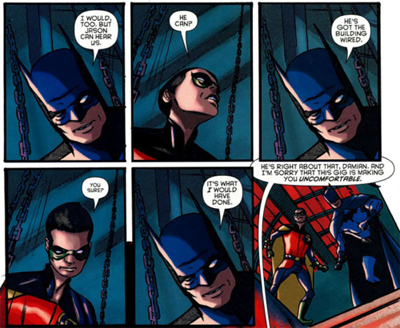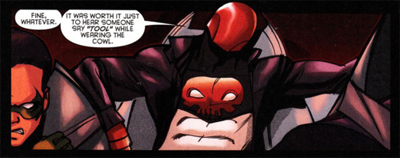To celebrate the release of The Dark Knight Rises, July is “Batman month” here at the m0vie blog. Check back daily for comics, movies and television reviews and discussion of the Caped Crusader.
Today we’re taking a look at three of the authors who followed Grant Morrison’s groundbreaking Batman & Robin run. And, rounding off our day of reviews, is Judd Winick’s three-issue arc.
I can’t help but feel a bit disappointed at how DC editorial handled Batman & Robin after Morrison departed. In hindsight, it’s apparent that they were waiting until the high-profile post-Flashpoint DCnU to relaunch the title with its new creative team of Peter Tomasi and Patrick Gleason, but that still means there were ten issues between the end of Morrison’s run and the proper start of Tomasi and Gleason’s. While using fill-in writers and artists might have seemed logical, I can’t help but feel like there should have been tighter editorial control of the book.
While Paul Cornell and Tomasi both maintained some association with Morrison’s well-loved run, Judd Winick uses the title to tell a three-issue story arc that doesn’t necessarily fit. Instead, this three issue story-arc feels like it should have been a miniseries or featured in an anthology title, fitting more easily within the character continuity of Winick’s resurrected Jason Todd than within any framework of Batman & Robin.
Winick was responsible for bringing back the second Robin to the world of the living with his celebrated Under the Red Hood arc, which I would love to see get a nice hardcover collection at some point in the future. He also wrote the well-received direct-to-DVD adaptation of that story arc. He has since guided the character, providing consistent characterisation and providing bridging material in the Red Hood: The Lost Days miniseries.
To many comic book fans who seriously disliked Jason Todd as the successor to Dick Grayson, Winick rehabilitated the character, finding a nice hook and sense of pathos to the young boy who had given his life in service of Batman. Winick presented the character as a vaguely sympathetic Punisher type figure within the Batman family, clearly upset that Bruce didn’t even care enough for him to kill the Joker in retaliation for his brutal murder at the hand of the psychotic clown. Enjoying an adversarial relationship with Bruce, the Red Hood is an outlaw who kills criminals, remaining a rather firm anti-hero.
Or, at least, that was how Winick imagined him. In the years following Jason’s revival, other writers have handled the character. That is, of course, to be expected. After all, Winick is writing within the confines of a shared universe. So Tony Daniel wrote Jason Todd into Battle for the Cowl following Bruce’s “death” in Final Crisis, presenting a psychotic avenger who sought to lay claim to the mantle of Batman. Claiming to be Bruce’s successor, Todd dressed up in his own”darker and edgier” Batman costume and took to killing criminals while rambling incoherently about his sense of entitlement.
Then Grant Morrison used the character during his second arc on Batman & Robin. While Tony Daniel portrayed him as a bitter and obsessive psychotic, Morrison instead portrayed him as something of an incompetent loser with little understanding of how crime works. Of course, that’s not entirely unexpected, given how Morrison feels about those sorts of “grim and gritty” anti-hero characters. This version of Todd was shown to be obsessed with his image, recklessly endangering a young child (ironic, given his own fate) and responsible for drastically escalating the gangland crime within Gotham. His lack of nuance and simplistic approach towards crime-fighting came back to bite both him and Batman when it prompted the mob to retaliate in kind.
From the outset, it seems like Judd Winick has been given a three-issue run on Batman & Robin merely so he can insult Grant Morrison, and ramble about how unfair Morrison’s treatment of his pet character happened to be. In fact, before he gets to the way Morrison handled Todd, Winick pauses to take a pot-shot at Morrison’s Final Crisis crossover and The Return of Bruce Wayne, arguably the two easiest mainstream targets for Morrison haters. Jason remarks that Bruce’s death involved “too much metaphysical horse crap,” echoing many criticisms on internet messaging boards, upset at Morrison for daring to challenge readers.
It seems like rather bad manners to allow Winick to write the last three-issue arc on the title purely to insult Morrison. After all, Morrison created the book Batman & Robin, and gave DC a book that sold well enough to continue after he left, as well as introducing Damian Wayne as Robin. It seems almost rude that the final arc should be devoted to Judd Winick complaining about how his pet character was treated and then using his pet character to insult Morrison’s pet characters.
Even the cover to the first issue in the arc, which is actually a clever and well-illustrated cover, reads like a direct challenge to Morrison. Winick’s Red Hood stands over the dead bodies of Dick Grayson and Damian Wayne from the cover of Morrison’s first issue, smoking guns in hand. The message is quite clear. And so we get set for three issues where Winick complains about the “goofy costume” that Morrison put on the Red Hood and spends three issues having his character humiliate Dick and Damian for quite arbitrary reasons. Winick tips his hand when he reveals a brilliantly implausible deus ex machina that makes Dick and Damian look like fools.
This is incredibly frustrating for several reasons. The most obvious reason is that Winick never actually explains what was wrong with Morrison’s characterisation. Instead of convincing us that Jason works best as a well-written anti-hero, he instead devotes pages and pages to Jason pulling off impossible stunts and incredible gambits. He takes cheap shots, instead of trying to convince us that Jason Todd is better written as a three-dimensional character rather than a shallow caricature.
There’s a lot of room for debate on Jason’s philosophy as compared to that of Dick or Damian. Hell, one might even make the case that Damian could even agree with Jason’s approach to crime-fighting. In the neon-saturated world of Batman & Robin, it should be possible to reframe the argument Morrison constructed, making a legitimate case for the Red Hood as the next-gen version of Batman & Robin. After all, the Jason Todd arc was the weakest three-issue arc of Morrison’s tenure, so it isn’t as if there’s no room for Winick to construct a fascinating counter-argument.
Hell, what about the character dynamics? There’s any number of interesting character dynamics that could play out in a story featuring Bruce Wayne, Dick Grayson, Jason Todd and Damian Wayne. Winick seems to acutely suggest this with his flashbacks, which very pointedly feature both a different Batman and a different Robin to those currently using the identities. Winick suggests that Jason bitterly sees Dick as “the good son” to Bruce, and it might have been interesting to develop this angle.
As awkward as the characterisation in Tony Daniel’s Battle for the Cowl might have been, there’s an interesting conflict to be played out between Dick and Jason, as brother fighting over their father’s identity. Hell, I would love to see a compellingly written interaction between Damian and Jason, the two more serious and brutal Robins. Part of me wonders if Morrison’s Damian wouldn’t have been tempted by Jason’s philosophy, even if he was anchored to his father’s family by loyalty? It would even have been nice to see more interaction between Jason and Bruce, contrasting their difficult relationship with the easy one that exists between Dick and Damian.
The problem with Winick’s arc is compounded by the fact that he doesn’t seem to have too tight a grip on Dick and Damian as characters, although he does seem to concede that at some points. “I’m oddly proud that you are finally utilizing youthful colloquialisms,” Dick remarks to Damian at one point, in what might be an acknowledgement that Winick is struggling with Damian’s voice, or another pot-shot at Morrison – possibly criticising the way Morrison writes a ten-year-old character that he created. I’m not entirely sure.
In fairness to Winick, he does write a solid Jason Todd, one who has a very particular way of speaking, a little wry and self-aware, but also occasionally painfully badass. Although, to be honest, I think Winick offers at least one classic Batman moment as Jason gets increasingly insufferable in the Batmobile, to the point where Dick openly calls him a “tool.” Jason leans back and responds, “It was worth it just to hear someone say ‘tool’ while wearing the cowl.”
Sadly, the focus on Jason means that Winick reduces Dick and Damian to the status of guest stars in their own book. Given that Dick would be replaced by Bruce in Tomasi and Gleason’s revamped Batman & Robin, it feels like a bit of a waste of their final arc together to play second-fiddle to a character like the Red Hood. On the other hand, though, I suppose that it is nice that Winick could give his own character a sense of closure before heading into the revamped DCnU.
That said, I’m also a little bit disappointed with DC’s collected editions department. After Winick’s brief three-issue stint, there was a nice done-in-one story before the massive relaunch of the DC universe. Written by David Hine, the issue might not have garnered great reviews, but it did feature an awesomely pop-art cover that fits well with the style of Batman & Robin.
It’s a shame that the issue wasn’t collected here (and, probably, never will be collected anywhere), especially given the fact that it would have fit in quite well with the disconnected nature of the fill-in work collected here. They could even have thrown in the annual story from David Hines that introduced the character he used in his one-issue fill-in. It wouldn’t have taken too much space, and it’s hard to argue that it was less deserving of inclusion than this “Jason Todd hijacks Batman & Robin” story arc.
Streets Run Red has some very serious problems, but they are compounded by the artwork. The three issues are a mess, featuring artwork from several different artists, each with very different styles. The problem isn’t that any of them are especially weak, but that the styles don’t necessarily fit together particularly well, and that some of them quite visible jar that neon aesthetic that Morrison established for Batman & Robin. It’s hard to believe that editorial couldn’t have structured the division of artistic labour better, perhaps reserving the fill-in artists for flashbacks or insets or something.
It’s a shame to finish an epic read of Batman & Robin on Streets Run Red, because it isn’t really a Batman & Robin story at all. Instead, it’s a Jason Todd story by Judd Winick. While the author has done some solid work with the character, it feels a little disingenuous to devote the last full-length arc of Batman & Robin to taking pot-shots at the author who created the title. I’m sure that there was a better way to tell this story, but it feels like a bit of a bum note to close the series on.
You might be interested in our reviews of other writers’ work on the first volume of Batman & Robin:
- Grant Morrison’s run
- Paul Cornell’s run
- Peter Tomasi’s run
- Judd Winick’s run
Filed under: Comics | Tagged: batman, batman & robin, batman & robin: streets run red, bruce wayne, damian wayne, Dark Knight Rises, dc comics, dick grayson, grant morrison, Grantmorrison, IGN, Jason Todd, judd winick, morrison, patrick gleason, peter tomasi, robin, robin (jason todd), streets run red, under the red hood, Winick |





























Totally agree with your analysis here. It is also sad after the excellent work he did in Under the Red Hood and Lost Days, that Winick should waste time infusing Streets Run Red with some subtle/unsubtle vitriol against Morrison rather than just telling a good story. The messy artwork doesn’t help either. Creators should hold true to their own visions and allow others to hold true to theirs. There’s room for more than one interpretation.
Yep.
It’s funny. Before I read comics, I thought continuity and character work were fairly linear and logical things; I actually bought into that crazy “it’s one big story” logic that some segments of fandom seem to hold to. Actually reading comics has given me a more nuanced understanding of the logic and workings of continuity. There can be lots of stories and lots of characters, filtered through lots of lenses. One lens does not (or should not) invalidate another, even if it plays with or riffs upon it.
In short, I have no problem with Winnick’s Red Hood being different from Morrison’s Red Hood, and spending three issues complaining about the difference seems to waste a lot of unnecessary energy and space.